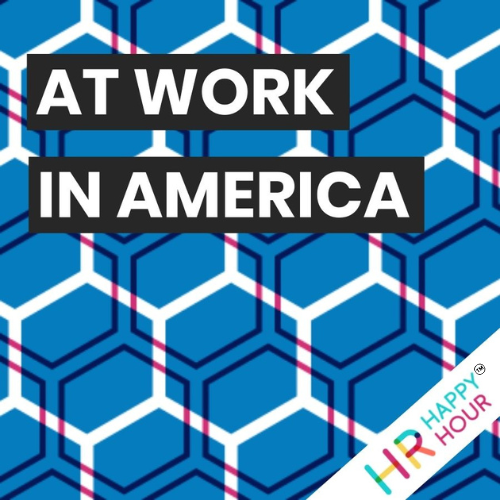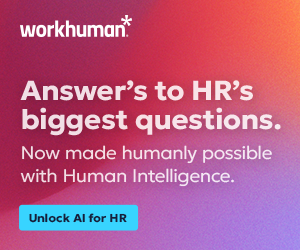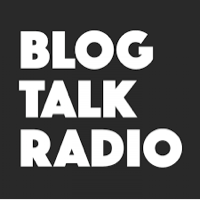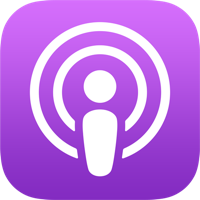The Essentials of Payroll Year-End and Starting 2024 Off Right
Hosted by

Steve Boese
Co-Founder and Chief Data Officer of H3 HR Advisors and Program Chair, HR Technology Conference

Trish Steed
Co- Founder and Chief Strategy Officer, H3 HR Advisors
About this episode
The Essentials of Payroll Year-End and Starting 2024 Off Right
Hosts: Steve Boese, Trish Steed
Guest: Tom Hammond, Vice President of Strategy, Partnerships, and Business Development, Paychex
This episode of At Work in America is sponsored by Paychex, one of the leading providers of HR, payroll, retirement, and insurance solutions for businesses of all sizes. Even the most seasoned professional can easily be overwhelmed by the critical tasks that need to be done during year-end. Download the Paychex Year-End Checklist to get organized. In it you’ll find timely tips, important deadlines, and advice backed by decades of experience to help navigate this time of year, so you don’t lose momentum as you transition to 2024. Visit paychex.com/awia to download your copy, today. That’s paychex.com/awia.
This week on At Work in America, we met with Tom Hammond from Paychex, to talk about the importance of giving your business a year-end check-up to start your new year right.
– Year-end planning and new developments in HR and payroll
– Year-end tax preparation and compliance deadlines
– Employee compensation and bonuses for the new year
– Talent shortages and retention in the workforce
– Improving employee benefits for multi-generational workforce
Thank you for joining the show today! Remember to subscribe wherever you get your podcasts!
Transcript follows:
Announcer 0:00
Welcome to At Work in America, sponsored by Paychex. At Work in America digs in behind the headlines and trends to the stories of real people making a difference in the world of work. And now here are your hosts, Steve Boese and Trish Steed.
Steve 0:26
Everyone, welcome back to the At Work in America show we have a great show for you today. It’s an annual show. I’m excited for it. It’s our year end, prep and review and prepare for the new year, our friend Tom Hammond is waiting in the wings to come and join us and talk about that Trish. Good to see you. This is probably one of the highlights of our our podcast year, I’d say.
Trish 0:49
It is. It’s good to see you as well. And you’re right. And this is the episode every year where I think, wow, I wish I could go back and be an HR professional, because of all of the things that we’re going to learn about and how to do them effectively and the things we don’t know about and how to get ready for the coming year. So it’s an exciting show.
Steve 1:09
And this is really an important time of year for HR people, payroll, people, benefits people, really everybody in the human capital business, right. We are we’re off Thanksgiving, we’re heading into the hot end of the year holidays. But we’ve got a lot to do, a lot to think about. There’s always a lot of changes, legislative updates, just best practices, good things to remind folks that they want to do as they work with their employees to the end of the year. So let’s welcome Tom, let me read Tom’s bio and welcome in officially, there’s been an update and exciting updates of Tom’s bio, Tom Hammond from Paychex, is here to help us talk about how to plan for year end and what is needed in the coming year. Tom has just assumed assumed the role of Vice President of Strategy partnerships and business development in December of this year. With more than 30 years of experience at Paychex. Tom leads an organization that develops strong, intuitive and relevant human capital management solutions for America’s small and mid sized businesses. Tom also shapes and directs the execution and acceleration of the company’s strategic partnerships, business development and future growth platforms, and is responsible for overseeing the payments ecosystem, including advanced partners and alternate capital solutions. Tom, that’s a big mouthful of things you’re doing Paychex. Welcome back to the show. It’s great to see you.
Tom Hammond 2:28
Great to see you, Steve. And Trish. Great to be with you always. This is my favorite show of the year for sure. Thanks for having me. Yeah.
Trish 2:36
Congratulations on the new responsibilities. I mean, that’s also on 30 years. That is an accomplishment alone in this day and age. Right. So congratulations on both.
Tom Hammond 2:49
Thank you for that. It’s an honor to be have been able to work here at Paychex and to support and build our brand over those 30 years. I’m honored to be one of 16,000 employees that work hard every day to try to drive small and medium sized businesses and let them achieve their goals.
Steve 3:08
Yeah. And then we know we know it’s cliche, but it’s true small and medium sized businesses. That’s the American backbone of the American economy. Right? You and I were part of a small business ourselves, right. And we live it every day. And so it’s awesome to have Tom and Paychex with us along the way on the At Work in America show. I mean, I don’t want to put a number out there, Tom, it was literally hundreds of 1000s of small and midsize businesses you guys support every year. And it’s an awesome ability. But it’s a great thing to so. Thank you both.
Trish 3:41
Let’s dive in. I would love to just ask Tom, I mean, you’ve been there a long time. What What role did you start in when you join Paychex? What was sort of that catalyst? I don’t think we’ve ever asked you before.
Tom Hammond 3:52
Yeah, I graduated from college in early May of 1990. And I joined Paychex on July 2 of 1990, in our payroll operations organization, and I was actually a payroll specialist. My first job at the company was actually taking payroll for about 400 organizations across the Rochester, New York landscape. 18 months actually learning payroll inside out and benefits inside out and helping those businesses get their employees paid.
Trish 4:25
I love that because I think that often, when you talk to different vendors, they may not have ever worked in human resources or worked in supporting human resources and employees before so I love that that was actually the very start of your career. So you started out with a really solid understanding of all of the intricacies of the payroll process and of benefits, which obviously goes a long way in what you’re doing and what Paychex provides.
Tom Hammond 4:52
Yeah, and one of the things I love most about my role today is being able to pick it pick up the phone and call clients and have discussions with them about out what’s working effectively for them and what keeps them up at night. And to have that strong foundation of my first several years in the organization has really allowed me to stay current. And I really enjoy that. Entrepreneurs are exciting individuals, businesses that have been in business for 20-30 years. They’re all facing the same challenges, which is about retaining their employees, finding new employees, finding new work, getting access to capital, making sure that their employee engagement is where it needs to be. It’s just a great career. To be candid, I love the HR field, I love being able to talk to businesses and figure out how we can build solutions that can help them focus on what matters to them. And it’s really an exciting time in the field today.
Steve 5:47
Yeah, it sure is Tom. And it’s it’s a dynamic one, it’s complex, but it’s also one that’s changed a lot over your career. Certainly our careers as well, where I can recall, Tom, I was part of a different small business many years ago, but I would phone in my payroll to my paycheck. I don’t think I spoke to you, Tom. But I spoke to someone who’s doing that. I remember doing it like every couple of weeks, right? And yeah, it was because the days before we had Paychex flex, and we didn’t have we didn’t have online systems to do any of this right. We were literally sending it in. Yeah, but good memories.
Tom Hammond 6:24
As I was reflecting on what to talk about today, one of the things that really started to come to mind is the technology that’s available today. And I think that back to my very first year and the in December of 1990. And we would take the better part of three weeks to produce W2s and get them in the hands of employees. And I’m coming to you today to say that we’re communicating externally that our W2s will be online on January 2, and 30 years in the business, it just blows me away to actually be able to make a statement like that externally. And the implications that that has on individuals, people want to get access to their W2. And for those that don’t have complicated returns, get their return filed, figure out if they qualify for a refund and get the cash in their hands which they deserve. And to just sit here today and say looking back 30 years ago to say, to ever be in a position to think January 2, when you log into Paychex Flex on your mobile app, you’re gonna have your W2 sitting there and waiting for you. It’s really just an unbelievably incredible journey to look back on.
Steve 7:33
That is quite pretty incredible. Tom, I saw that in the in the notes before we started the show. And I thought I thought maybe that’s a typo like I didn’t think no, perhaps even possible. But thank you for saying that and making sure I understand that it’s not a typo as well. So Tom to get ready though, to get yourself and your organization to that say January 2 date or whatever date it’s going to be that you’re ready to, to get your W2s out there and to sort of start the new year. What are some good recommendations that that you and the team at Paychex have put together and recommend folks just think about as we you know, we got about a month to go before year end that folks should should be thinking about and then proactively doing.
Tom Hammond 8:15
For me, it’s always come down the month of December, I like to position it as a time to ensure you that your house is in order. And to get your house in order, there’s really three areas that I always recommend that businesses focus on. The first is make sure that your business data is in order. The second is make sure that the data for all of your employees is in high quality and an order. And then the third is probably one that has emerged over the years because at year end, you have an amazing time to really reflect on the last 12 months and re recruit your top talent, or quite frankly, re recruit your entire organization by giving them something of a reward statement, something that’s personalized to them. And to me, Steve, it would start with really understanding your employee information. That’s that’s number one. And I always like to start there.
Tom Hammond 9:10
And if we look back at what we’ve learned over the last three years through this COVID experience, there’s a lot of policy changes that organizations have been introduced. And that’s really opened up some challenges for payroll and HR. Quite frankly, being able to work remotely anywhere, opens up and puts pressure on a business from a tax perspective. And you really need to ensure that your policies, your employee handbook, everything is really locked down to understand where’s my employee working? Where do they live? Because that nexus is going to drive where you need to pay taxes. And quite honestly, we’re still seeing a number of small businesses and medium sized businesses that haven’t really locked that down yet. And when I say lock it down, it’s not making it very complex. It’s just saying Hey, Steve is actually residing here now he moved. If Steve forgets to file the appropriate W4 or state withholding information, you’re gonna be withholding taxes from the wrong place he’s going to be overpaid on one underpaid on another. That’s a big challenge. So I’d start there, for sure.
Trish 10:18
I wonder if you see this, I mean, especially with more than small and medium sized businesses, you may not have all of the technology in place to easily monitor that. So if you’re still a small business, and you’re trying to do this in Excel, or trying to do it in a series of other documents, or websites, maybe that are just not connected, I think you put your business at risk. Could you talk a little bit about maybe how to lessen the risk? Because I don’t know, again, that all small businesses might not be focused on that aspect of it as well.
Tom Hammond 10:49
Yeah, I would say foundationally, I always recommend starting with a solid employee handbook, or a set of policy statements, and those, to me are the blueprints of success for any business. If you start there, then you’ve got an opportunity from an HR perspective to have a common language. So it’s never going to be something that, hey, that’s new to me, as an employee II, or I didn’t know that was our guiding principle or our policy, writing it down. And you don’t have to do this in formal software. It’s certainly easier to do if you use formal software. But you can get an employee handbook in place in with technology today, in short order. And no matter what size of your business, what size business you’ve running, having that handbook to me is most important. It’s a foundational bedrock of any HR policy. And then from there, you can really guide your organization to the Northstar what matters, what’s important to the organization, what’s appropriate and not appropriate. And then there’s no surprises.
Tom Hammond 11:52
So I would say that’s my first recommendation on that Trish. And when you’re looking now and kind of heading into December, that policy with that handbook will drive the policy things like are you carrying over vacation and time off? Are you given access to volunteer days? And do those carryover? Do you have an FSA in place? And does that carry over? What’s the benefit packages that are available to you? Do they vest on particular timeframes? Or are different annual award days? So if you kind of use that as your guiding Northstar, again, to me, for small businesses, that’s a really strong recommendation. And then from from all of that, you really need to start now looking back at your year and understanding, did I write any handwritten checks? Did I do anything off cycle? Do I have deductions like a personal use of a company vehicle that needs specific tax calculation associated with it or Group Term Life insurance, or your 401k matches in order all of that you want to make sure before you get to the end of December, or that January 2, w two is going to be need to be pulled back. Because there’s going to be some modifications required.
Steve 13:08
Tom, you eloquently talked about some of the internal organizational updates, policy changes, even compensation changes that might kick into effect with the beginning of the new year that an organization has to be ready for. And there’s lots of of those things, right? changes in policies, procedures, and things like that. But there’s also a lot of external, right, sure, requirements, right that come down the road for HR and Payroll folks to deal with. We can’t go into like every last form you need to fill out and all those things, but maybe Tom just share some thoughts around preparing or finding the right resources to prepare your organization for necessary filings creating in filling out the proper forms, and just the really kind of compliance related things that organizations need to have in mind and be ready for.
Tom Hammond 13:58
Okay, I would say this year is another year, where we’re going to see a significant volume of minimum wage increases. So we are seeing those across the local and the state level at unprecedented rates. Last year, it was even more than 20. We’re in 20 this year. That’s really important for a number of reasons. First of all, it starts with your first payroll in January. So you need to be there in order to be compliant. So I would say, start there. And when we finished today, I’m going to talk about a website that we have stood up for any business to leverage@paychecks.com. So don’t need to be a client of paychecks to come and take advantage of the information that we’re providing on that website. And we’ve set one up directly for your for our listeners here today. But I would start with their minimum wages 20 of them what’s gonna happen next with those does that create any type of wage compression issue and what’s going to happen next with that, so be thinking about what is the implication of essentially introducing a new minimum wage across your organization. Next, I would say think about the actual distribution dates of particular forms, obviously, Form W2 and W3, need to hit the filing by the 31st of January 949 40. Ones, all your state returns, your 1099 for contractors need to be there by January 31. Those are all deadline driven, nothing new, we joke about it here at paychecks year end is going to happen, it’s going to happen at the end of December, you’re going to need to file by January 31. And we talk about it every year on a round and round basis to figure out how we can get more efficient and effective. And then obviously, your annual business tax returns, march 15, for partnerships for LLC s, for s corps, April 15, for C corps, but we’ll we’ll lay those all out on the site that I’ll give you access to and when we finished this afternoon.
Trish 15:51
Yeah, it’s so nice to have you kind of package everything that way for us. Because I think that that’s the thing, when you’re running your own business, you might be thinking, I can take care of this myself, I only have a handful of employees. So you’re not necessarily thinking because you’re thinking about running your business itself. Maybe in the product or service, you’re making or providing some of the things like wage compression. I mean, I made a note, when you said that I you might think like, oh, I just need to worry about the minimum wage and not really be thinking about how many other people might be impacted if you don’t make a change. So I do appreciate that you’re, you’re sort of making those additional reminders of things that people can be doing to make sure that there is equity, right among the employees as well.
Tom Hammond 16:37
And I think that the the federal government and the state governments are beginning to mandate on new job postings, the actual wage values beginning to end which is typically what we see is you see a range. And obviously, that’s for good reason, because there’s going to be individuals that are in that range. And there’s a range created, because there’s always a different level of experience that is available in any job or role that a company has and accompany is going to establish the importance of that role, what they’re willing to pay for that role. And then they’re going to have different individuals that play in that. That’s another one that’s really important. When you think of wage compression, minimum wage that affects a particular role could immediately put someone with less experience in the same category of someone who has a significant volume of experience, what are you going to do about that? And when you think about that, does that start changing employee engagement as you post a new job online and see that the range goes from A to B? And then you’ve got a very experienced person? That’s looking right now? Like they’re being paid similar to someone with less experience? And is that what you want as the message as the employer to your employees? That’s a statement that needs to be wrestled business to business. So I think that’s a great example of some external pressure or external environment that is changing the way that HR professionals look at business today.
Trish 18:04
I agree. I’ve been listening to several different sources talking about how colleges right are now sort of promising certain starting salaries to different degree programs. And the students are going out and getting them and it’s shockingly high. So I think to if I’m an employer, I also want to be maybe touching base with some of the, you know, local universities and colleges to see what are some of the starting salaries just to even prepare, because I know, one of the things I know you’d love to share with us is to really start talking about planning for pay increases and bonuses in the coming year. But I think part of that also is thinking about what are, you know, recent college grads expecting and receiving as they take these new jobs and how that impacts that planning? Could you maybe talk a little bit about planning for the new year in general, and then maybe how looking at university starting wages is going to impact that?
Tom Hammond 19:02
Yeah, as you look at starting a new year, you have an opportunity to reset, and many businesses use the calendar year as a cycle to determine what is the performance increase that we’re going to budget for the calendar year? Is it going to start January? What are we going to do it on an anniversary basis? Each business is is different, but usually on a on a year to year basis of businesses sitting down and saying what are our budgets? And we start with the budgets to determine what we have available to actually spend to drive the earnings that are going to be required to keep that business healthy and growing. And some of the things that immediately come to mind is okay, where are we from an annual wage increase? And what do our wages look like in comparison to other businesses that are in our geography, the competitors that we’re competing against in our industry or for the talent that we need to grow in our industry? Are you considering end View your bonuses as a way to take an exceptional year and share the wealth with the employees? If so, how much are you allocating? And how are you going to communicate that and I just want to stop for a second because I think that really opens up an opportunity to do a couple of things.
Tom Hammond 20:17
When you start talking about an end of your bonus, it’s, it might be something that someone’s not accustomed to, and to be able to leverage that dialogue to say, hey, we had an exceptional year and every employee made a difference. In us achieving our results, here’s an opportunity for you to share in that message carefully understanding how not only you craft that message, but now you’re into the technical execution of delivering a year end bonus, how do you want to do that, with technology today, you can leverage real time payments, you could you can run a separate payroll run, leverage real time payments, pay someone in 15 seconds, and it will show up in their account. So think about the implications of that, because there’s some amazing implications to run it separately. But don’t lose out on the opportunity to have that discussion with your employee. And make sure that they know how much you appreciate what they’ve done. And then quite frankly, to me, it comes down to having a discussion that I like to turn the total investment that we made in you, or the total investment made in them. That’s a much different dialogue than having a total compensation, discussion.
Tom Hammond 21:24
And when I think of that, Trish, there’s so many opportunities here. To me, I like to really sit down at the end of the year with my team, and re recruit them and say we had an amazing year. And you were a big part of that. And here’s what you accomplished over the course of the last 12 months. And to sit down and actually say, paychecks or the this company has made this investment and you go into sales mode. And I I tried to preface it this way. We have great recruiters here at Paychex, and they’re talking about our company culture, what we do across the United States to build communities, small or medium sized business can do exactly the same thing. And to go back to sales mode with the folks that may have been with them for 30 years, or for three years, 30 months or three months, and have a discussion that really sounds like that. And really position here was your total cash wages, you received a bonus this year, we sent you to training, we introduced a set of training for you, we gave you volunteer day, your company in retirement or health care.
Steve 22:30
Exactly. Health insurance, retirement contributions, right. Things like that. Right? Of course. Got it, Tom, that’s a great point too, because I know Paychex, of course, publishes the Small Business watch and keeps your finger on the pulse of what’s happening in the labor markets, particularly for small businesses. I’m a fan of that data as well. And we know both from the data as well as anecdotally. Right. Most organizations are still, you know, in that mode of, hey, we’re, we’re struggling to find the right people, we’re struggling to retain them, it’s very, very important to retain them. You could go I mean, every single day I read another story, whether it’s a pharmacy, it’s a firefighters, whether it’s teachers, construction workers, first responders, right, it’s all across the board of have talent shortages, and staffing shortages all across this country. So you know, when you have those good people, those people who are helping your organization, certainly, you know, thrive and serve customers, you, as you said, Tom, sitting down with them taking a proactive opportunity to talk to us use the technology, use the data that’s available to you and really have that conversation, because otherwise you could find yourself in really, really a pickle and 2024. Because talent, it’s not, you know, that’s not it’s not going to get easier, I guess I’ll say it that way to find and retain talent.
Tom Hammond 23:51
It certainly is not, in recruiting that top talent and having that open dialogue to understand what matters to them. We’re spending a lot of time here at Paychex trying to understand the benefit offerings that would match a five generational workforce. I mean, this is a really complicated time to run a business of any size. What matters to me at year 30+ is much different than someone who’s just coming from that local college that you described, Trish, with the benefits that are important to me don’t match. All of the generations inside of that. We’re really in a unique time, it puts pressure on HR to actually create a diverse package. But on the same token, it makes it exciting because that’s what’s fun to me about HR, you can’t have HR without human and the HR individual is the person who’s coming in every day thinking about the team that’s making a difference of that, at that business. And when you look at the so many, so many different types of demographics that are in the workforce today. This is on time, it’s a challenging time. But it’s a fun time to be in the HR profession for sure.
Trish 25:05
I think, Tom, that you are absolutely right. And when you give the you’re sort of doing a roleplay, like what you would say and what you could say, right during these types of meetings and having real communication. So it’s not just about sending out a total reward form. Right, exactly. There’s no context around that. But I mean, what you’re describing is really building a trusted relationship or extending a trusted relationship with employees. And I think that when you’re talking about that five generations span, and what’s important, to me, that also opens up the fact that you might be your age talking to an HR leader who is 30. Right? So you might not even be aware of what someone who’s in their 50s What from a benefits package, right. But yeah, they are influencing or a decision maker in what the benefits plan looks like. So it’s actually a way to help both sides, right, you’ve helped the people who are making those business decisions about what the benefits offerings are, or how payroll is going to be handled, right, how salaries are going to be handled, but you’re also getting added perspective from all the generations. And I think that I don’t know if you’ve seen this in your career, but it feels like to me, we often look to see like right now everyone’s focused primarily on Gen Z, right? We always focus on sort of the incoming, I don’t know that I’ve ever worked anywhere where we really focus on sort of looking at every every phase of a lifecycle and what they might need, because having student debt is a little bit different than buying your first home than having your children than paying for college than paying for retirement. Right. So there’s, it’s such a wide array, are you? Are you seeing that your customers are having those kinds of conversations? Or is this something that they can also really be doing to improve that connection between the generations?
Tom Hammond 27:00
I think there’s no doubt that any business can improve the the dialogue that they’re having around benefits. I’ll start with that. I am talking to businesses, though, that for the first time in my career, are looking at multi generations and thinking about how do I have as an example, a student loan repayment benefit. But if I offer a student loan repayment benefit, there’s a number of folks that that’s not going to apply to, but I need that in order to try to drive this generation of the workforce to my company and to be a differentiator. And then they’re thinking on the other end of the spectrum to say is there some type of benefit that we could put in place that would help a person who maybe in their 40s, or 50s, that brings us and their parent into their home and needs to help them take care of them as they move towards the end of their life or the last phase of their life? Those are very interesting dialogues. And it’s, like I said, it’s very exciting to actually be in a position to think creatively with something. And in many ways, what we found is that businesses sometimes think about, what’s it going to cost me to actually introduce that. And what we’re seeing lately is that employees are actually equally excited if you do the homework for them. If you create a curated experience, where you vetted some folks that are able to do to provide services for one of these generations, if you’ve done that work, and there’s a tremendous trust in you as the HR professional there, that makes a big, big difference, because let’s face it, time is the one thing that you can never get enough of, and anything that you can do to try to streamline something for another person is is great. So really exciting, really, really exciting time.
Trish 28:47
Good advice.
Steve 28:48
I’m glad you talked about that time as well, you know, both this kind of idea of re recruiting your your your talent and your people and communicating with them more openly around benefits, offerings, the value of benefits, the role, you know, the role the organization complaint, helping support people at various life stages, as Trish mentioned, because we’re as we always position this as Hey, get ready for year end, kind of a shell. And it is right, it’s got W2s, you’ve got forms and 1099s and all kinds of tax filings and Paychex, we’ll help you get through all of that, don’t worry. But there’s so much more opportunity there for organizations as well beyond just the as we like to say around here, H3, the bare minimum, right? If you just do the bare minimum, right, you can keep your company compliant, and that’s great. And it’s important, but there’s so much more that you can do. And I think Tom, you’ve you’ve been very, very eloquent and kind of, you know, inspirational as well to say, Hey, don’t just think about the forms and the pricings and the processes, think about what you can do and what we can all do a little bit better for next year, which I think is great.
Tom Hammond 29:53
Yeah, there’s a couple of things too, that I could just close with. It’s interesting. One of the things that that we do daily is interact with the Internal Revenue Service. And what’s interesting is that they’re putting out a free online tool this year in 13, states that they’re piloting to create, basically a direct file program, and it’s free through the IRS. So there’s a series of states that you can find on irs.gov backslash direct file, there’s 13 states. And it’s a very simple form process to actually create your taxes and file your taxes electronically for simple returns. It’s designed for simple returns to make that really clear. Going back to those folks who are receiving their W2 on January 2, if you’re in one of these states, it might be something that’s worthwhile to actually leverage the program and see how that see how that works. So it’s interesting to see how things are have come together and how much they’ve changed over the 30 years, since I started in this industry, for sure.
Trish 31:01
I love all of these resources. For you, Tom, like you’re always, that’s the one thing about this show every year is you bring the resources, right. So I love that people have things they can actually go out and do and take action on and feel not just informed. Steve, to your point. I mean, obviously, part of the reason of the show is to help everyone feel informed, but also to feel a little bit in control. And so you can start really making a difference in your organization. If you’re, you know, feeling like you haven’t been doing that maybe, or just looking for some new creative ideas.
Steve 31:33
You mentioned Tom, we have Paychex as resources available. So let’s get that URL out now. And we’ll also make sure it’s in the show notes, too. So where can folks go to access? The Resources Information, Tom, that you’ve been talking about? Go directly to paychex.com?
Tom Hammond 31:51
paychex.com/awia
Steve 31:53
I love it.
Tom Hammond 31:56
At Work in America, you got it? Yep, it’s available there, it’s available immediately take take the opportunity to go in, I think you’ll find that we’ve spent a considerable amount of time trying to think through everything from A to Z, so that you have the opportunity to take advantage of that and leverage it no matter what size your business is. That’s really the key. And I think that’s probably the most important message from Paychex, we serve businesses from one to several 1000 employees, and no two businesses are the same. So we create tools and checklists and try to think about things that would make a difference, no matter how big or small you are. And again, we started the show by saying small and medium sized businesses are what fuels the US economy. And I couldn’t agree with that more.
Steve 32:44
Great, great stuff. Trish, I love getting together with Tom, of course, we were lucky enough to see Tom and the team out of HR Tech a couple of months ago where, by the way, I have to share that as well. If you haven’t had a chance to see the video that we did with Tom’s team, and Nathan ran the video for us of some of the new tech capabilities, Paychex is rolling out specifically around helping organizations make better decisions, right, and you have an insight and to make decisions around compensation and whether or not they’re paying people fairly and competitively and all that and so much more. Right? There’s, and having the ability to have those kinds of tools, why brought it up Tom was not just because it was a cool video, which it was, was having that kind of insight and that kind of technology available to small and medium sized business was that’s a new thing, right? That wasn’t the case, when we started our careers, right, you had a fortune 100 company to have access to that kind of data and those kinds of tools. And now any size organization can have access to them. And certainly with the resources, both from the technology side, and the information and support side that paychecks provides small businesses can can be on a level competitive playing field with any other business in the country, which I think is pretty amazing, too.
Trish 34:01
I would also add that you might even be ahead of some of the large enterprise size companies because, you know, since we are a small business as well, I obviously when I’m out and about in the world, I asked employees of all different types, about their payroll about their benefits, how do they process that? How do they receive that? How do they feel about the information? I was actually in a hospital yesterday talking to some radiology workers. And so again, very large health system, they were saying they don’t have a lot of these tools that I know I saw not just in the video, Steve, but in the Paychex booth. So I would encourage you if you’re listening to this, please please check out Paychex and their solutions because there are many larger companies who do not have these types of solutions in place. And from a recruiting standpoint. employees want this right so as you have access to it and you can make their ability to check their payroll and In their benefits and make changes very easily and on their phone.
Steve 35:07
Tom mentioned real time payments, I want to do like, my next video, I want to be about real time payments, because I want to dive in like it in a major way, because it’s so fascinating to me.
Tom Hammond 35:17
Look, we tell you, yeah, that is a fascinating, it’s been fascinating to watch that we were the first in the market to bring that to bear. And the businesses that actually come through and say, You know what, I missed someone, I want to pay them a bonus, I want to do it immediately. And probably what’s most impactful is you can run real time payments, on weekends, on holidays. And off it goes. And literally in about 15 seconds, you’ve processed and you’ve moved the funds that an employee deserves to his or her account. That’s a powerful, powerful tool. And you guys, we’ve talked about this many times, there’s nothing worse than a Friday, when you have an error on payroll, and then it feels like you’re working all day to figure out how to fix it, those days are gone. If you miss something, if you need to correct something, you can process a payroll in seconds, so you can move the funds in seconds. And it’s as if you didn’t have that, that black mark on your record with that employee. And that’s the most important part of this is to get that trust back fast. ,
Trish 36:21
Tom, the other thing that provides is if you are the person processing that error, or that that bonus, or whatever the case may be, you’re also giving that person back time with their family as well, because I’ve been the payroll person that’s had to stay over and come in on a Saturday and try and manually fix things. And in losing time with my family, many times that’s happened, right? So it does, it absolutely builds trust and credibility with your employee. But it also really benefits the person who’s either processing it or in charge of, you know, approving that. And I don’t know, I literally cannot even imagine what that would have done to my life. If I had had that.
Steve 37:05
You know, we’ve really just scratched the surface of all the incredible opportunity. There’s out there for small businesses, but certainly, we want to remind everybody again, go to paychex.com/awia for year end resources, strategies, tips, access to everything you need to know to get yourself ready for year end and year began. And we’ll put that link in the show notes as well. Tom, great to see you. Again. It’s our favorite show of the year. Hope you’re well and happy holidays early. But we this will probably be our last long conversation before them. And good luck getting everybody and the hundreds of 1000s of Paychex clients ready for the new year.
Tom Hammond 37:46
Thank you, Steve and Trish and before I say goodbye, I just want to acknowledge and thank you for what you are doing for the HR profession, what you’re doing week in and week out. To really raise the game have the opportunity to be an HR professional here. I much appreciate it. Hope you have a wonderful holiday season.
Steve 38:05
Thank you so much, Tom. That was awesome. All right. paychex.com/awia. Go to hr HRHappyHour.net for all our show archives. Trish, great to see you and this has been a great show. So I would say for you, for our guest Tom Hammond and all our friends at Paychex and all our listeners. Thanks so much for listening. We will see you next time and bye for now.
Transcribed by https://otter.ai
Talk to us
If you want to know more about any aspect of HR Happy Hour Media Network, or if you want to find out more about a show topic, then get in touch.










